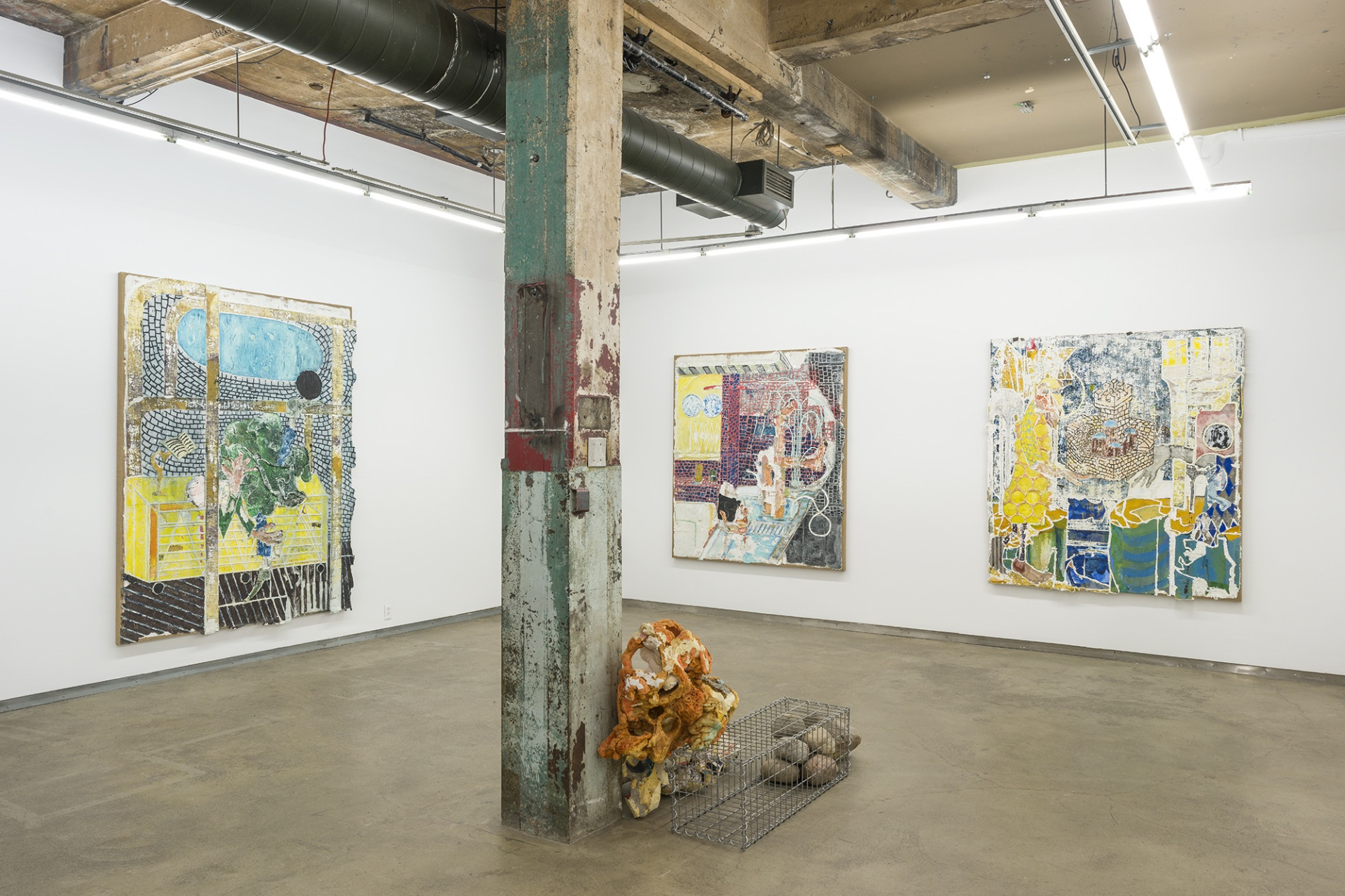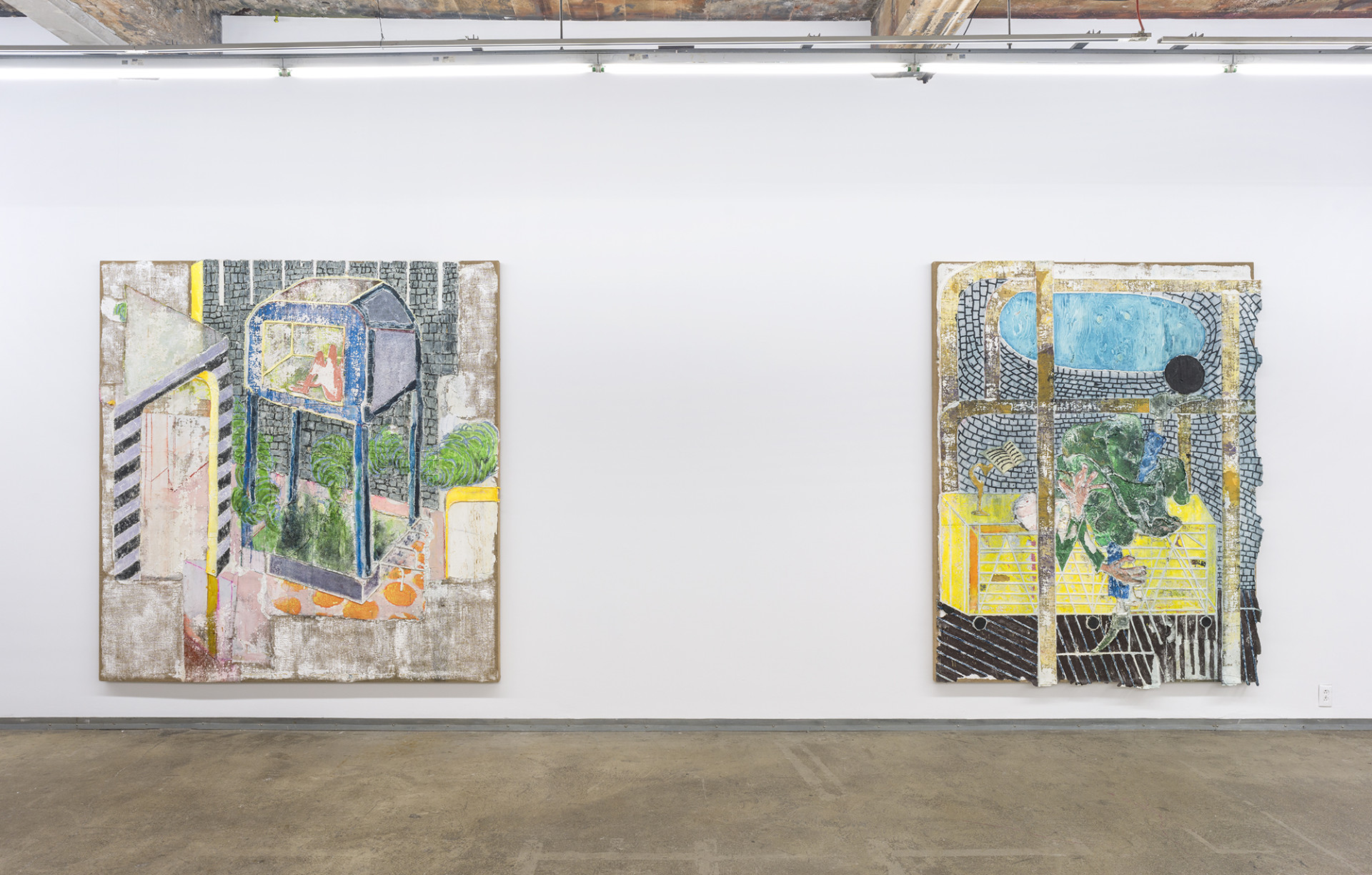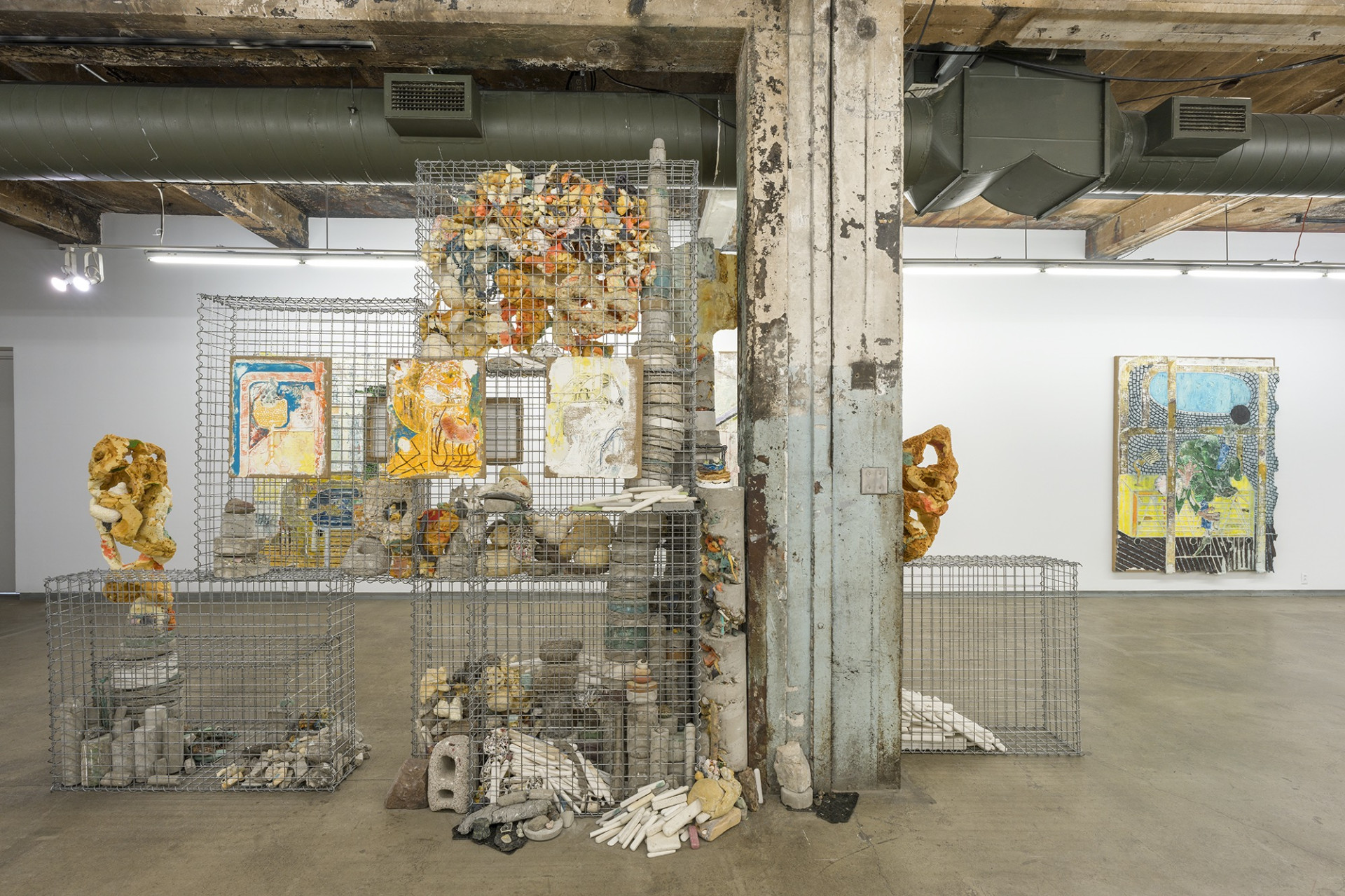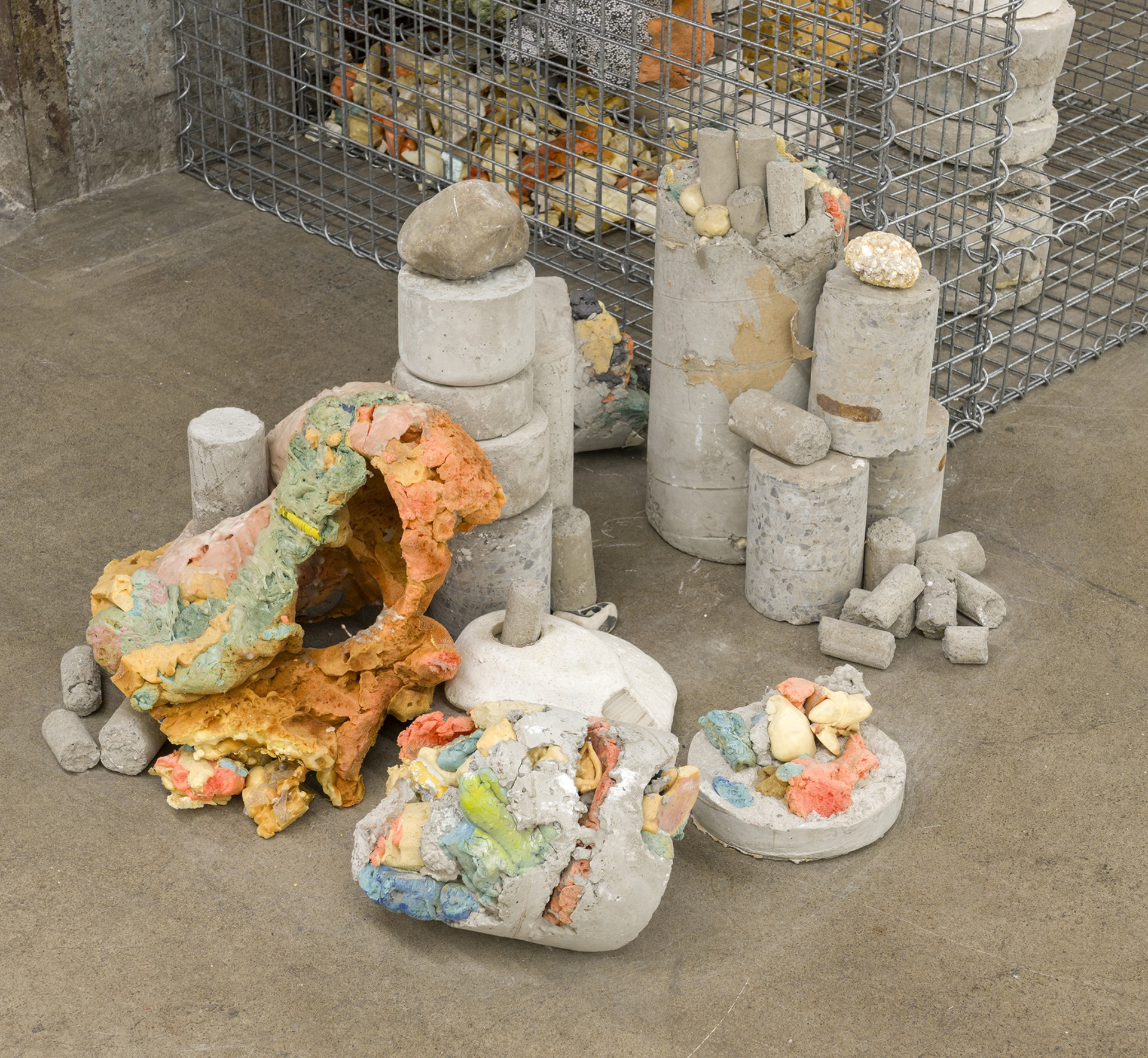



James Gardner’s art stands out for its dense textures and fossilized images, the barely perceptible, fleeting traces of phantoms. In a style imitating the wear and tear of time or even the effect of decay and decomposition, he constructs his works by employing multiple techniques in a rigorous and intuitive process. Cutting and collage are first used to develop the composition. Drawing on scraps strewn all over his studio floor and relying on chance, a play of full and empty pictorial spaces, he recuts certain pieces of canvas, redefining them by recycling and integrating them into a new composition: “I have rather obsessively kept every piece that has been scraped off my paintings,”1 Gardner explains. After he’s established the composition, the artist makes transfers onto different surfaces, using engraving techniques on a plywood board, reused and showing traces of his previous works. By covering the forms in gesso and transferring them to a jute canvas, he obtains a kind of bas-relief into which he reinserts his original elements. This specific engraving technique, the alternation between positive and negative space, the transfers from one surface to another, and the superpositions of atemporal layers create a distance to the original image, which deteriorates with consecutive migrations until only its residual trace remains. These “ghosts in the carving,” as the artist calls them, these inframince images from which myriad beliefs could emanate, just like from the Veronica relic,2 reflect his selection of images, most of which are borrowed from Greek and medieval iconography and form the basis of his artistic lexicon. Esotericism, alchemy, astrology, and other occult sciences, which have been rejected, ignored, or even hidden in Western culture, are Gardner’s subjects of choice:3 “I have tried to present a conception of images wherein they can exert some sort of agency as well as embody a spectral and platonic form,” the artist clarifies. Resonating in Gardner’s work is a form of the “surviving” image, an important concept of art historian Aby Warburg who re-envisioned the conditions by which we read and interpret images in his project Mnemosyne Atlas. This term is used in studies of iconology to evoke Warburg’s ideas on the migrations of images, which are simultaneously “trace and line, fossilized imprint and energy flow, paralysis and movement.”4 Philosopher Georges Didi-Huberman, having extensively examined Warburg’s concept of survival in a book focused on his work, describes it as follows: “It is something or someone that always comes back, survives everything, reappears at intervals, and expresses a truth concerning an original state of affairs. It is something or someone that one cannot forget, and yet is impossible to recognize clearly.”5 According to Didi-Huberman, the life of an image, in all its manifestations and variations, can be conceptualized as “chunks broken off from the mountain, broken stones, sediments.”6 This metaphor resonates in Gardner’s installation through the introduction of elements alluding to geological processes, whether the natural one of sedimentary deposits and alluvium or the intentional one of core sampling, in which residual materials are cemented. Gabions, cages of galvanized iron filled with rocks, typically used along riverbanks or as retaining walls to prevent erosion and landslides, become attempts to prevent the erosion of material and image. For the artist, “these elements also act as armatures and scaffolds to help hold up paintings, these objects emphasize that each painting lives amongst an ageless ecology of images in various states of becoming and decaying.”7
The contrast between the tenuousness of images migrating from one work to the next and acting as palimpsests and the complex texture obtained through an idiosyncratic technique activates the dialectical effect that is so meaningful in Gardner’s work.
Caroline Andrieux
Translated by Oana Avasilichioaei
INTRODUCTORY VIDEO
[1] “I cannot help but think of these scraps as some sort of image-vehicle or image-matter, as they still hold traces of the painting they helped build…this materiel excess accumulates in my studio in little poles alongside paintings. As I clean and rearrange the studio these piles get subsumed into a large pile in an oft used corner. This pile also accumulates with material waste and these scraps over time begin to fuse together. With some sculptural and aesthetic exaggeration, this process lead to the Gonshi-esque, coral like forms that pepper the exhibition space.” James Gardner, “Vessels and Broods” (Master’s thesis, Concordia University, 2020).
[2] Such as the Veil of Veronica, which set off Catholicism, as author Thierry Davila evokes in De l’inframince, Brève histoire de l’impercetible.
[3] This exhibition offers the artist an opportunity to present his most recent pictorial experiments, created after a research visit to Greece and Turkey. Seeing the collections at the Byzantine and Christian Museum in Athens and the Museum of Byzantine Culture in Thessaloniki and meeting the Orthodox monks at the Monastery of Dionysiou on Mont Athos and the Keșlik Monastery in Cappadocia were powerful experiences that led to the creation of a series of works of varied sizes.
[4] Jean-Pol Madou, “Temporalité de l’image: Aby Warburg et Carl Einstein,” in Mythe et création, théorie et figures, edited by Éléonore Faivre d’Arcier, Jean-Pol Madou and Laurent Van Eynde (Brussels: Presses universitaires Saint-Louis Bruxelles, 2005), 69–85 (our translation).
[5] Georges Didi-Huberman, The Surviving Image, Phantoms of Time and Time of Phantoms: Aby Warburg’s History of Art, trans. Harvey Mendelsohn (Philadelphia: Penn State University Press, 2016), 13.
[6] Didi-Huberman, The Surviving Image, 206.
[7] Gardner, “Vessels and Broods.”
James Gardner
Born in Kitchener Ontario in 1983, James Gardner currently lives in Montreal. After completing his MFA at Concordia University in 2020, Gardner’s thesis work was awarded both the Petry Award and William Blair Bruce European Travel Scholarship to conduct field research at Monastic sites in Greece and Turkey looking at historical and contemporary icon painting traditions. His graduate work and recent research has been centred on collaborations with institutions like the Warburg Institute and other image archives and historical sites related to the study of Western esoteric image traditions. Gardner’s work has been supported by several scholarships, prizes, and awards including the TFVA Artist Prize, the Joseph-Armand Bombardier Canadian Master’s Scholarship, and multiple grants from the Canada Council for the Arts, the Toronto Arts Council and the Ontario Arts Council.
